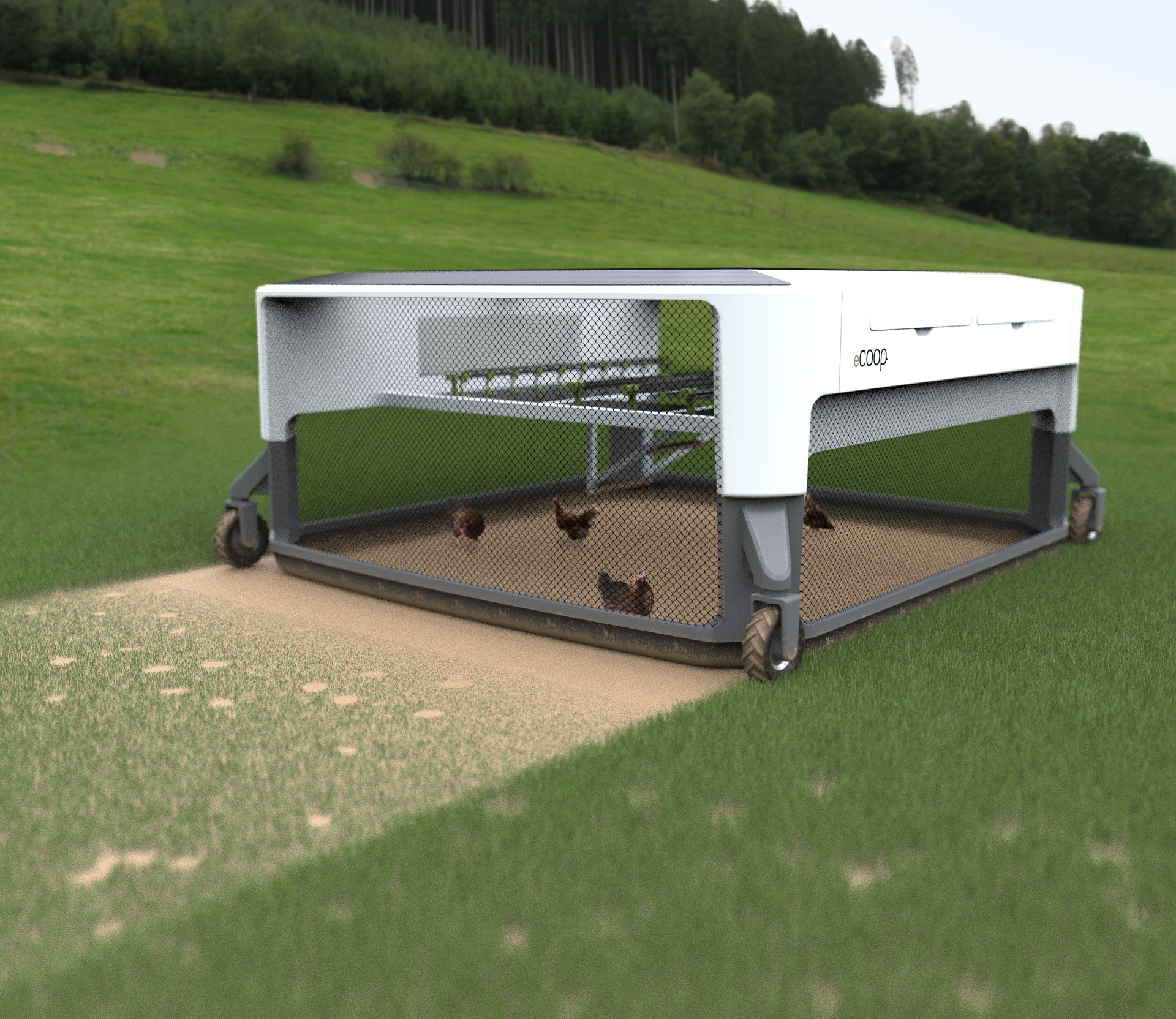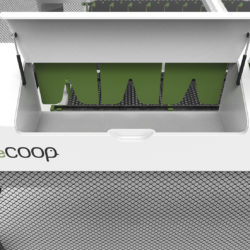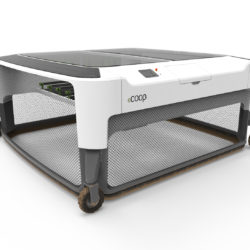eCOOP
Description
The eCOOP describes an autonomous chicken house that interprets the chicken's behaviour as a benefit and creates the optimal environment for it. Picking and scratching frees the ground not only from weeds, but also from pests by eating them. The excrement can be used directly as fertiliser for the soil.What is the Topic?
It is obvious that the use of the earth by humans is not sustainable. Climate change only demonstrates a man-made environmental threat. If humans do not use their resources more efficiently, they will sooner or later face major problems. Soil, for example, is an important basis for life and a resource that is only partially renewable. It fulfills many different functions necessary for life. For agriculture, soil fertility is a decisive factor. But soil and agriculture are not only mutually dependent. They are also particularly important for the protection of water, air, climate and biodiversity. The exploitation of soil as a resource through intensive agriculture, therefore, has far-reaching consequences for humans, animals and nature. It is clear that new ways must be found to respond to this situation. The question of how we can practice agriculture in the future is shown, for example, in the concept of permaculture. It has nature as its inspiration and teacher and proposes a design concept that uses traditional practices, modern science and technology to imitate the diversity and resilience of natural ecosystems in order to develop similarly functioning systems for the use of human needs. How the soil can be positively influenced and worked in this sense can be illustrated by the chicken and is also the basis for the development of the eCOOP concept: In the concept of permaculture, the chicken is not only seen as an egg producer but also benefits from other behaviours such as pecking, scratching and excrement. Picking can be seen as natural pest control, while scratching can be seen as digging up the ground and weeding. The droppings also serve as a direct natural fertiliser.
Why does it look like this?
In order to guarantee that the chickens are kept in a manner appropriate to their species and to get the most out of the chickens, the eCOOP has its characteristic shape: The eCOOP has a total surface area of 16m2 and a height of 1.5m. On its surface there is room for up to 30 chickens (which is above the bio-standard). It has two levels. So the entire lower floor area can be used in the best possible way and the areas "spout" and "nest" are clearly separated from each other. In any case, the seat and nest must generally be on a higher level, because chickens are naturally forest animals and seek shelter in elevated places. The lower level is kept completely free of everything but the ground. Also the excrement cannot get into the chickens' feed area. With the second level it is also possible to store the electronics, the feeding trough and the drinking trough. The feeding trough is filled via a flap on the frame. There it feeds the animals for some time. The drinking trough is operated with a pump. The corresponding water tanks are also located in the frame. On the opposite side are the breeding boxes. There are six of them, which are sufficient for about 30 chickens. A flap in the frame makes it easy to remove the eggs at a comfortable height. The two solar panels on the outer frame ensure that enough energy can be collected to power the eCOOP with sufficient energy. The generous, transparent panoramic roof and the four side panels made of simple wire mesh not only offer the chickens protection from birds of prey, but also ensure that the open design does not make the animals feel trapped and caged. They can perceive and feel the sun's rays and the natural light in their environment. In combination with the nets inserted in the side panels, the chickens can experience the wind as well as the sun, which always provides air circulation and fresh air. The transparent, almost invisible surfaces literally stand for the transparency in this concept. You should be able to see how the chickens live. The roof glazing is able to darken itself by means of an electrochromic foil. During the day it provides natural light and suggests an open sky. At night the electrochromic roof turns on and darkens the henhouse to emphasize the natural day-night rhythm. It gives the chicken the feeling of being in a safe shelter while sleeping. The function is based on the chickens' natural preferences both during the day and at night. In addition, the roof glazing can also be switched independently of each other and of the day-night rhythm. For example, on hot summer days to create shadow places and regulate the temperature inside. The eCOOP is programmed with the help of a previously determined route and from then on it runs along this route continuously. It reaches a maximum speed of 0.15 km/h. During the night, the henhouse stops to avoid disturbing the chickens in their sleep. The low speed ensures that the chickens can sufficiently work the entire route they are travelling. The 4 wheels on the outer edges of the eCOOP can be turned through 360° and rotated independently of each other. They each have their own motor in the rim. Thus, not only forward and backward, but also sideways navigation is possible. The deep tread pattern of the tyres also allows driving on sandy and wet ground.
What is special?
The special thing about the project is to see the chicken not only as an egg producer, but to understand it as part of an ecosystem that lives in interaction with nature. If one accepts natural behaviour as a benefit to the soil, the chicken's full potential is revealed. In addition to the ecological advantages and animal-friendly husbandry, the eCOOP opens up the possibility of making optimum use of the chickens' potential as living pest and weed killers. Because the chickens are in a defined area that is in constant motion, a previously defined area can be worked precisely. Within the framework that has been created, the chickens clean the soil of pests and weeds through their natural behavior and fertilize the soil at the same time as they manure - completely CO2 neutral thanks to the solar-powered, autonomously driving eCOOP. As a further benefit, the hens supply eggs.
What is new?
What is new about the concept is to look beyond the horizon and to understand nature as part of a complex system that can bring far more benefits to humans than the current status quo. Using the example of the chicken, the concept of eCOOP gives an important impulse towards sustainable, future-oriented agriculture in the sense of permaculture.




